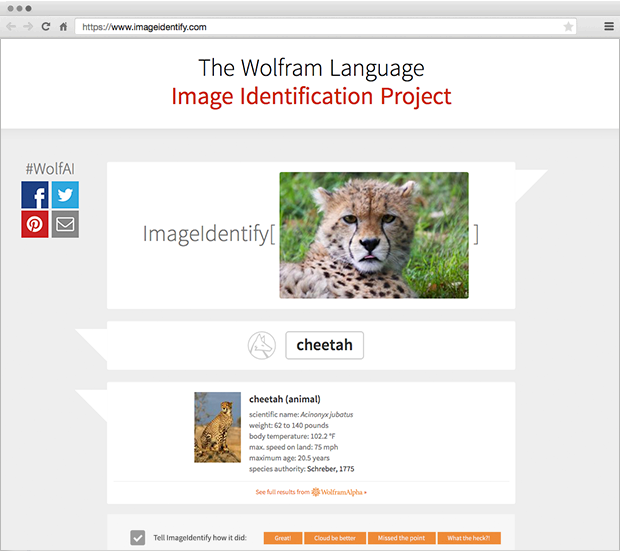May 16, 2015 weblog
Wolfram's ID project launch touts ImageIdentify function

You see a picture but you cannot name it. "What animal is this?" "Hmm, sort of looks like a guitar, not a cello—what is this instrument?" The Wolfram Language Identification Project was launched on Wednesday to answer such questions. The project page invites visitors to drag any picture from a group (drag a pic from a web page, snap it on your phone, or load it from a file) and find out what ImageIdentify thinks it is: After you drag a chosen image over to the square, you immediately get a list of facts about the object and if you want to know more, it takes you to the Wolfram|Alpha page where you can ask anything beyond the information you got.
Stephen Wolfram, founder and CEO of Wolfram Research, blogged about the launch on Wednesday: "'What is this a picture of?' …there's finally a function called ImageIdentify built into the Wolfram Language that lets you ask, "What is this a picture of?"—and get an answer."
Wolfram also said, "we've reached the point where we can integrate this kind of 'AI operation' right into the Wolfram Language." (The Wolfram Language is a knowledge-based programming language.) He considers it a "powerful building block" for knowledge-based programming. With ImageIdentify built into the programming language, one can create apps that use it, too. The Wolfram Language runs interactively on the desktop, cloud, and mobile.
Wolfram said that "Underneath, of course, it's just running code—with very simple inner loops that are pretty much the same as, for example, in my neural network programs from the beginning of the 1980s (except that now they're Wolfram Language functions, rather than low-level C code)."
In explaining how the project works, Wolfram said that it is "effectively a built-in classifier trained from a large curated set of images tagged with Wolfram Language concepts. The main part of the current ImageIdentify classifier is based on deep neural networks."
Commenting on neural networks, he said, "Humans can readily recognize a few thousand kinds of things—roughly the number of picturable nouns in human languages. Lower animals likely distinguish vastly fewer kinds of things. But if we're trying to achieve 'human-like' image identification—and effectively map images to words that exist in human languages—then this defines a certain scale of problem, which, it appears, can be solved with a 'human-scale' neural network."
The project page, once you dragged over an image, asks you to rate how the page did—from "Great to "Could be better" to "Missed the point" to "What the heck?"
Wolfram acknowledged that it won't always get it right, "but most of the time I think it does remarkably well."
Looking to what's next, Wolfram said, "We'll continue training and developing ImageIdentify, not least based on feedback and statistics from the site. Like for Wolfram|Alpha in the domain of natural language understanding, without actual usage by humans there's no real way to realistically assess progress—or even to define just what the goals should be for 'natural image understanding'"
ImageIdentify is being progressively enhanced, he said, "especially with training data derived from feedback given by users of this site."
© 2015 Tech Xplore





















